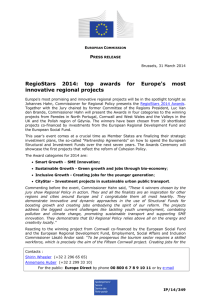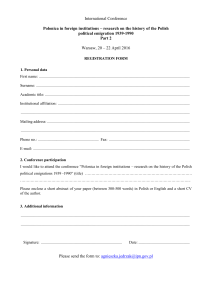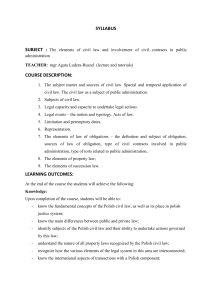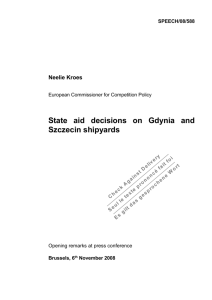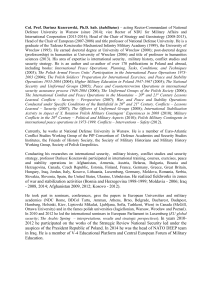Gdynia - The sea, my city and me
advertisement
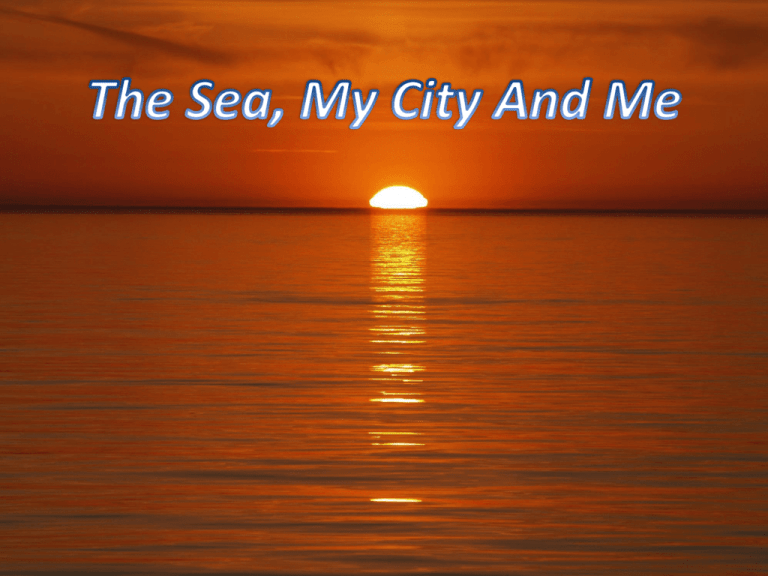
The Sea, My City, And Me For the first time Gdynia was mentioned in a document from 1253, under the name Gdina, a village belonging to the parish in Oksywie. In 1414 the first inn was built - a meeting place for fishermen and a social-shopping. Because of the convenient location by the sea, in the early twentieth century Gdynia became a seaside summer resort. It was visited by numerous Poles from the centre of the country who stayed in Gdynia. After joining the region, the Polish began a new period in the history of Gdynia, which became the site of the construction of a seaport. The port of Gdynia was built, because it really was an independent Polish seaport. The port in the (The oldest monument of Gdynia) Free City of Danzig was, which under the Treaty of Versailles was a stateless city, to be used freely by Poles and Germans as they were to have equal rights. But in reality, the Poles were discriminated. In April 1923 there was an opening of the temporary port, and in August the same year the first seagoing vessel sailed to Gdynia. It was the SS Kentucky, under the French flag. On February 10, 1926 Gdynia received the city rights - as it already had 12 thousand people. In 1934 Gdynia became the largest port on the Baltic Sea in terms of cargo volume, and also the most modern port in Europe. II World War caused significant damage to the port and a small part of the city. The dynamic development of the port (container base) and other infrastructure lead Gdynia to be the fastest growing city in Poland. In December 1970 Gdynia shipyard workers and residents protested against the existing political order. The reaction of the security forces were dead and wounded. These events are commemorated with such monuments as the Monument of the Victims of December 1970 which stands nearby Gdynia Shipyard as well as 23-foot cross that stands at the City Hall. Today the city is still one of the most important and most modern ports of the Baltic states and is one of the largest Polish cities. 1870 – 1 September - a railway line linking Gdańsk to Gdynia, and Wejherowo to Sczecin was opened 1920 – 10 January – Pomorze Gdańskie was included in the Polish territory on the basis of the arrangements of the Peace Conference in Paris 13 February – Gdynia’s marriage with the sea at Redlowska beach. 1925 – houses in Gdynia were lit with the light of electric lamps 1926 – 10 February – Gdynia was promoted to be a city. 1927 – 6 January – Polish flags were raised on the first merchant ships bought in France. The same year Gdynia received the telephone lines 1927 – the first journey of the city’s means of transport 1929 – the creation of a football club called Arka Gdynia. SS Kentucky 1930 – the consecration of the ship „Dar Pomorza” in Gdynia’s port; raising of the polish flag on the first polish passenger ship “Polonia”. 1939 – 1 – 9 September – the Heroic Gdynia’s defence as well as the defence of Kepa Oksywska from the invasion of German army 1943 – first „trolejbus” in Gdynia (in Poland are only 3 cities which has got „trolejbusy”. In Gdynia are one of the most modern in Europe) 1967 – visiting French president Charlesa de Gaulle’a 1987 – visiting pope Jan Paweł II 1990 – opening ferry line to the Karlskrona in Sweden Solaris Trollino 12m (trolejbus) Stena Spirit in Gdynia’s harbor Świętojańska Street Boulevard Pier Arka Gdynia’s playing field He was a legendary sailor, an admiral of the Danish Fleet. There was no Polish Fleet at that time, so Polish sailors were mercenaries in other countries. According to the legend, he reached America before Christopher Columbus. He had managed to hand in his maps to Christopher Columbus before he died. Jan of Kolno studied at Cracow University in 1455. He was probably born to a family of sailors or merchants settled in Gdańsk. The engineer Tadeusz Wenda, is a person who immediately comes to mind when people say "Gdynia". He received a job as a construction manager at the port of Gdynia in the Ministry of Industry and Trade. He chose the place for the construction of the port. He was the author of the technical concept and site plan as well as a works manager. From 1932 he supervised further works, as a clerk in Marine Board in Gdynia. After I World War Poland regained independence after 123 years of partitions, but it wasn’t known which lands will eventually be included as part of Polish territory. Gdynia was and is in Kaszubian region. Kaszubian region is a land in Pomoranian region, which is inhabitted by the Kaszubian ethnic minority. They speak their own language and they have had their own culture till this day. Kaszubians, beside having their own sense of individuality, have always felt as the Polish. Abraham, as a keen defender of Polish Pomoranian and Kaszubian region, decided to go to Peace Conference in Paris. There he wanted to convince the governors that the place where he lived (Pomoranian and Kaszubian regions) should be included in the territory of his beloved country. The legend says, he went to Paris on foot! He was said to hit the table with his big fist (he was more that 2m tall) and said “There is no Kaszubian region without the Polish, and no Poland without Kaszubian region”. Abraham’s opinion had to have a positive effect on the members of the conference as after such long time the Pomoranian was given back to Poland. Kazimierz Porębski was Polish Vice-Admiral and the Commander of Polish Navy in the years 1919-25. In the first years of independence he has become the central figure of Polish politics in the sea. This activity was characterized by extraordinary dynamism and dedication. Porębski occurred to be an activist, an organizer, and the main spokesman of maritime affairs in his work. He was also a propagator of building a port in Gdynia. Leonid Teliga was a Polish sailor who sailed round the world single-handed. He started his voyage on 25th January 1967 in Casablanca. He visited a great number of ports en route, warmly welcomed in many places in the world and nominated an honorary member of various yacht clubs. It took him 2 years and three months to complete the race. He accomplished his voyage on 30th April 1969. An ambulance waited for him at the Warsaw airport. In spite of intensive medical care, Teliga died on 21st May 1970. He was a Deputy Minister, Chancellor of the Exchequer, Minister of Industry and Minister of Trade in II Rzeczpospolita (RP). All the greatest economic achievements of II RP are related with his activities . The most important economic enterprise was the port construction in Gdynia in the years 1926-30. This main investment was strongly supported by Kwiatkowski, who did everything to accelerate this building. While he was in charge of the marine politics the significant activities took place to enable the shipping industry in Gdynia. Thanks to them Gdynia had possibility to become one of the biggest and the most modern ports on the Baltic Sea. Unfortunately after the II World War because of the communists politics he was banished from his own country and till his death he could not come back. Every year people are awarded with the medal of Kwiatkowski for their outstanding contribution to Gdynia. He carried on the construction of the first Polish hitech yacht “Gemini” and founded a yacht shipyard “Gemini International”. In 1999 he inaugurated the programme Race 2000 –the participation of a Polish crew in the round the world regatta. In 2001 Roman Paszke decided to break the record of sailing round the world single-handed without calling in at any ports. The current world record is held by a Frenchman, Francis Joyon (57 days, 13 hours, 34 minutes). Because of the bad weather conditions on the southern hemisphere the voyage had to be cancelled. Roman Paszke did not give up and started a new race on his 90-feet catamaran “Gemini 3”. He was going to beat the world record of non-stop single-handed sailing round the world “against the wind”. Unfortunately, because of a serious damage of his catamaran, Paszke had to stop his race in January 2012. In spite of that, he is going to continue his preparations for the next trial. The current world record is 122 days, 14 hours, 3 minutes and 49 seconds. Many sailors tried to sail “against the wind” in the past, but only six of them succeeded, including one woman. At the beginning a little about the street itself: Świętojańska Street is one of the longest streets in Gdynia (1866m.). Along the street there is an unbelievable amount of shops, restaurants, pharmacies or other private companies. How is this festival celebrated? The Festivals is on 23 June. This festival is nothing else but a nameday of Świętojańska Street. We shouln't forget the fact that on the same day there is the St. John’s night. Along the street there are many stages set up and there is a lot of different things being done, shown or presented at each stage. For example, at the first stage there is an artist who sings, while at the next one some well-known Polish chef shows how to cook some typical Polish dish. In addition, there are prepared numerous playgrounds, slides and other attractions for children. But the main attraction is the parade. Depending on the theme these are the parades where the army, fire brigades, acrobats, clowns, antique vehicles and many other people take part. November 11 is unusual for all Poles. Every year on the streets of cities of our 11 of November in unusual allhundreds the Poles.of Every year theofstreets of who citieswish in our country, country comefor out thousands citizens are filled with hundreds thousands citizens who to celebrateinthe retrieval of to jointlyofcelebrate theofrestoration ofwish independence 1918. independence in of 1918 For 9 years city authorities and residents Independent" have celebrated Since 9 years ourtogether. city authorities andour residents celebrate "birthdays "the joyful Independence " with a joyful parade. Also last year at This 12.00parade the IX Gdynia’s parade. birthday Every year on the Gdynia’s streets is parade. starting Independence Parade began took route, since the before waristimes, near railway station and and going to the the traditional Kościuszko Square. On this parade double leading from the Constitution Square, 10Haller February Street, until it Kwiatkowski reached the Polish Sailor’s of Józef Piłsudski, Józef and Eugeniusz Plate at the Kościuszko Square. It was attended, among others by: -the Marshal Józef Piłsudski -the General Józef Haller -the Engineer Eugene Kwiatkowski - Deputy Prime Minister who was involved in the creation of the city and the port of Gdynia. The herring march takes place since immemorial time but since 2002 it is an official celebration called "The herring march". It is a pedestrian march, with the length of about 13km, which takes place on the Tern’s Shallow at Puck Bay between Rewa and Kuźnica. The march is organized to popularize the tourism at Puck Bay and on the shallow itself. This march consists of four stages: "the faith", "the Moses’s syndrome", "a test" and "only to the seashore". During the march every participant has to eat specially prepared herring and needs to drink a special sailor’s drink. The first stage called "the faith" requires the participants to go into the sea in Kuźnica and slowly move away from the seashore of the Hel’s Peninsula. After about 500 metres they have to start swimming. The second stage called "the Moses’s syndrome" makes the participants go through the water up to the level of their knees till they reach the dry land which is a small, long and narrow island which cannot be seen from Rewa or Kuźnica. The name of this stage is symbolic and is compared to the biblical Moses’s walk through the sea during exiting Egypt. The third stage is "the test". Participants have to eat specially prepared herring and drink a special sailor’s drink made of unknown ingredients. The fourth and the last stage is called "only to the seashore". It is the hardest stage of the march because the participants have to swim through the artificially deepened part of the shallow which is 700 - 1400m wide (depends on the sea currents). During the summer editions the participants swim through this stage holding to the help line from the fishermen’s boats. If somebody lets go of the rope he needs to get onboard a boat. From there... …to there. The tradition of the sea days dates back to XVIII and XIX century when the kaszubian fishermen had a custom of cutting the mushrooms’ parasol at the Midsummer's Night. The parasols were a symbol of evil and human nuisances. Those ceremonies like throwing the garlands in spring had only the folk character never national. On 6th December there has been a motorcyclists Santas parade for 9 years. People wearing Santa’s suits ride through the streets of Gdynia, Gdańsk and Sopot. The route leads from Gdynia to Gdańsk, or from Gdańsk to Gdynia. The first rally was held in 2003 and then 9 people rode through the streets. In 2007 there were 757 motorcyclists in the streets whereas in 2011 about 2500 people. Everyone who has a motorcycle and is dressed as a Santa can come. Of course, he or she needs to have a motorcycle driving license. During the parade voluntary donations are collected for children and they are transferred to one school in Gdynia and one in Gdańsk. We think that you enjoyed our city ;)
